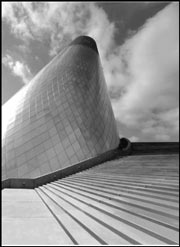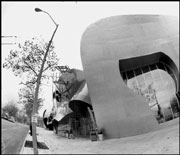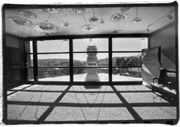MUSEUM OF GLASS: INTERNATIONAL CENTER FOR CONTEMPORARY ART
1801 East Dock St., Tacoma, 253-396-1768 opens 10 a.m. Sat., July 6
Tacoma’s new $63 million Museum of Glass and International Center for Contemporary Art (MG) opens to the public this weekend. The crisp, lucid building marks a welcome return to modernism for designer Arthur Erickson, widely regarded as Canada’s greatest architect, who in recent decades has made several unconvincing forays into arbitrary form making and pallid postmodernism. (Seattle’s Harbor Steps, for example, falls into the second category.)
The building’s signature is a 90-foot-high, tilted stainless steel cone—a reference to both volcanic Mount Rainier (which was earlier called Mount Tacoma) and to the sawdust burners used in timber processing. The cone, too, is a place of inner fire, housing the museum’s hot shop: Amphitheater seating faces a battery of kilns and furnaces, where glassblowing demonstrations will take place. (Dale Chihuly himself will be leading his crew Saturday night.)
The interior of the cone is a striking architectural space with a glazed oculus top not quite large enough to ad-mit the amount of light it deserves and surmounted by a square ventilation fan because a round one cost too much. (There is other evidence of “value engineering”: wire mesh was used for the exterior parapets, for example, instead of glass as originally planned. Erickson ironically told the press: “Glass is too expensive for us to use.”) The museum’s terraced rooftop also features such Erickson hallmarks as reflecting pools, long ramps, and cascading staircases.
The latter elements are especially important and visible since patrons will often enter the build-ing from the roof. The museum sits on the flats along the Thea Foss Waterway, cut off from downtown proper by railroad tracks and a freeway spur. The 500-foot-long Chihuly Bridge of Glass links MG’s roof with the core of the cultural district. Designed by its native-son namesake and Texas architect Arthur Andersson (no connection to the accounting firm), the much-ballyhooed span, costing about $17 million, is a letdown: It lacks the presence, form, grace, and character that mark great bridges and is instead a big, plain catwalk for the display of about 1,700 Chihuly artifacts. If you’re a fan of Chihuliana, you’ll love this bridge; if not, you may still find the idea of an outdoor glass display to be an appealing curiosity. There is 24/7 security planned for the bridge to deter theft and vandalism, leading one to wonder whether the museum can bear such an expense permanently.
Once across the bridge, you may take an elevator down into the museum, but it’s better to descend the rooftop ramps and stairs, zigzagging past a Buster Simpson glass sculpture—installed temporarily but it deserves to be made permanent—and other outdoor art, including Howard Ben Tre’s plaza-level “Water Forest” (not quite finished for the press opening), an internally lit bronze, glass, and water piece that looks promising and which could be especially poetic after dark.
The museum lobby is another fine space, featuring a stepped ceiling formed by the underside of the grand roof staircase. However, the exhibit gallery is more workmanlike than inspired, with no provision for natural lighting. Inside, some splendid cast-glass pieces by Czech artists Stanislav Libensky and Jaroslava Brychtovᠤemonstrate that not all glass art needs to look like it belongs in a gift shop.
MG is located on an esplanade that is part of a slowly gentrifying industrial waterway (it’s built on a Superfund site). But it isn’t easy to find by car; the museum recently saw fit to give a navigational workshop for local cab drivers. Its immediate neighbors are less than ideal visually: A massive condo and apartment development seven stories tall dwarfs it on the north, and a dark, drab, nearly windowless flour mill flanks it on the south.
Tacoma has high cultural ambitions for a city of its size, especially one in the shadow of a much larger and more glamorous city. MG advances those ambitions both as an institution and as architecture; the new quarters of the Tacoma Art Museum, under construction two blocks away, will take those aspirations even further. Hats off to our southern sister city.
info@seattleweekly.com 







